|
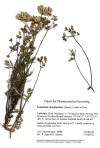
Lomatium
caruifolium
Mariposa Co., CA
Spjut 14755, May 2002
Note: Preliminary Identification by R. Spjut was L. marginatum.
This was
reidentified by Roger Sanders to L. caruifolium
|
 Lomatium
californicum
Kern Co., Caliente Ranch, CA. CNPS Chapter/Nature
Conservancy Field Trip,
24 May 2013 |
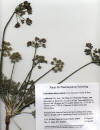
Lomatium dasycarpum
San Diego Co., CA
Spjut & Marin 14673, April 2002
|
|

Lomatium dasycarpum
Kern Co., CA.
Piute Mt. 30 Apr 2005 |

Lomatium latilobum
Arches National Park, Utah
May 2008
|
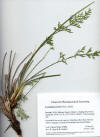
Lomatium parryi
Clark Co., NV, Spjut 15292.
May 2003 |
|

Lomatium
scabrum
Utah—Great Basin Desert-Plateaus. Dixie NF: Garfield Co.: Summit on east
side of Hwy 12, ~15 mi south of Torrey; 38º02'06.4", 111º19.42.1", 2936
m. Alpine meadows near quaking aspen forest. Perennial from a tuberous
root, flowers yellow, fruits immature. Common in heavily grazed meadow,
Richard Spjut & Paul Burchstead 16371, 24 June 2008.
|
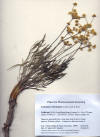
Lomatium triternatum
Lassen Co., CA,
Spjut & Casterline 14791.
June 2002 |
|
|

Lomatium utriculatum
Carrizo Plain—Elkorn Plain, Kern Co., CA,
5 March 2010 |
|
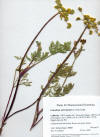
Lomatium utriculatum
Los Angeles NF, CA,
Spjut 15183; April 2003 |
|
Chou S. C., M.
C. Everngam, G. Sturtz and J. J. Beck. 2006. Antibacterial activity
of components from Lomatium californicum. Phytother. Res.
20(2):153–156.
“The isolation,
characterization and bioactivity testing of compounds from Lomatium
californicum (Nutt.) are described. Ethyl acetate and hexane extracts
of the roots of L. californicum were subjected to vacuum liquid
chromatography (VLC), flash column chromatography (FCC) and separation by
normal- and reverse-phase high-performance liquid chromatography (HPLC).
Six compounds were isolated successfully and characterized by 1D and 2D
nuclear magnetic resonance (NMR) experimentation. The bioactivity of the
known compounds (+)-falcarindiol, coniferyl ferulate, ferulic acid and
(Z)-ligustilide were confirmed against the Gram-positive bacteria
Bacillus subtilis and Staphylococcus aureus. The known
compounds senkyunolide I and trans-neocnidilide were also isolated but in
too small a quantity for similar testing. Copyright 2006 John Wiley &
Sons, Ltd.”
Lee T. T., Y.
Kashiwada, L. Huang, J. Snider, M. Cosentino and K. H. Lee. 1994.
Suksdorfin: an anti-HIV principle from Lomatium suksdorfii, its
structure-activity correlation with related coumarins, and synergistic
effects with anti-AIDS nucleosides. Bioorg. Med. Chem. 2(10): 1051–1056. “Suksdorfin
(1), which is isolated from the fruit of Lomatium suksdorfii, was
found to be able to inhibit HIV-1 replication in the T cell line, H9, with
an average EC50 value of 2.6 +/- 2.1 microM. In addition, suksdorfin was
also suppressive during acute HIV-1 infections of peripheral blood
mononuclear cells, monocyte/macrophages and the promonocytic cell line,
U937. Combinations of 1 and the anti-HIV nucleosides ddI and ddC
demonstrated statistical synergy in inhibiting HIV-1 replication (ddC >
ddI). However, the viral inhibition mediated by combining 1 with AZT was
not statistically synergistic. Furthermore, the presence of suksdorfin did
not antagonize the suppression mediated by the three nucleoside reverse
transcriptase inhibitors. Comparison of the structure and activity of 1
with those of ten related compounds indicated that the dihydroseselin type
of pyranocoumarin possessing a 4'-isovaleryl group is important to
suksdorfin's enhanced anti-HIV activity.”
Meepagala K.
M., G. Sturtz, D. E. Wedge, K. K. Schrader and S. O. Duke. 2005.
Phytotoxic and antifungal compounds from two Apiaceae species, Lomatium
californicum and Ligusticum hultenii, rich sources of Z-ligustilide
and apiol, respectively. J. Chem. Ecol.31(7):1567–1578. “The
seeds of two Apiaceae species, Ligusticum hultenii and Lomatium
californicum, were investigated. Preliminary bioassays indicated that
methylene chloride extracts of seeds of both species contained selective
phytotoxic activity against monocots and antifungal activity against
Colletotrichum fragariae. Active constituents were isolated by
bioassay-guided fractionation, and the structures were elucidated by NMR
and GC-MS as apiol and Z-ligustilide, isolated from L. hultenii and
L. californicum, respectively. Apiol and Z-ligustilide had I50
values of about 80 and 600 microM, respectively, for inhibition of the
growth of Lemna paucicostata. The methylene chloride (CH2Cl2)
extracts of the seeds and the isolated and purified compounds were tested
against the 2-methylisobomeol-producing cyanobacterium (blue-green alga)
Oscillatoria perornata, and the green alga Selenastrum
capricornutum. The CH2Cl2 extracts of both Apiaceae species and apiol
were weakly toxic to both species of phytoplankton, while Z-ligustilide
was toxic to both with a lowest complete inhibitory concentration (LCIC)
of 53 microM. Seeds of L. californicum and L. hultenii were
found to be rich sources of Z-ligustilide (97 mg/g of dry seed) and apiol
(40 mg/g of dry seed), respectively.” |